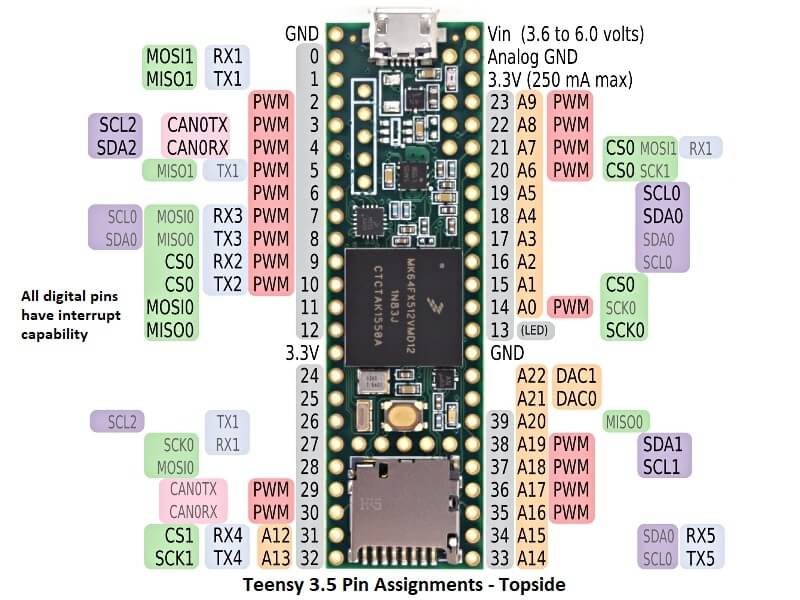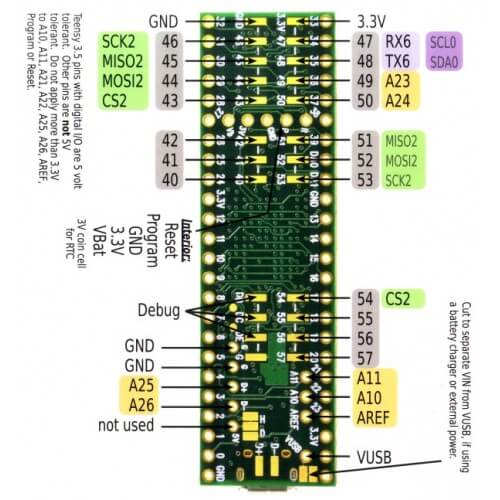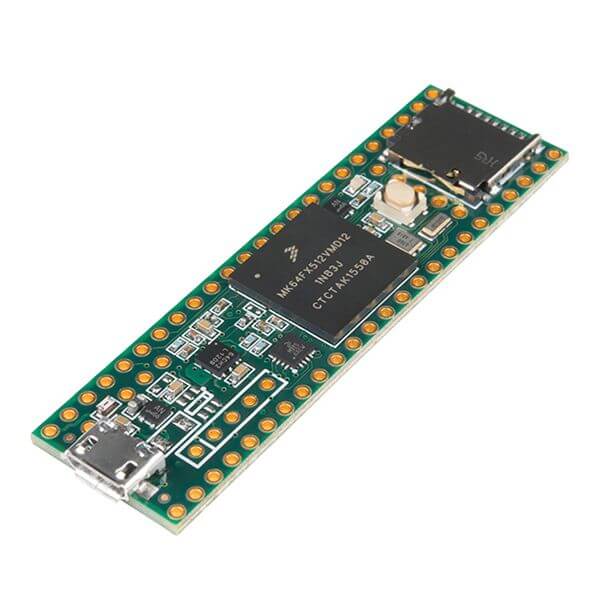The Teensy 3.5 is a development board with a 32-bit ARM processor. It has a large number of interfaces and high computing power, enabling it to be used in a wide range of applications. In particular, it can emulate USB devices, so is often used to develop HID or MIDI peripherals.
Microcontroller features
The Teensy 3.5 microcontroller uses the ARM Cortex-M4 microprocessor. This processor operates at a clock frequency of 120 MHz, and has 256 kB RAM, 4 kB EEPROM and 512 kB Flash memory (for programming and data storage).
|  |
The Teensy 3.5 microcontroller also features an SD card slot for storing files for websites, for example…
Power supply
The Teensy 3.5 microcontroller operates over a voltage range of 3.6-6V, thanks to its on-board voltage regulator, while the microprocessor operates at 3.3V. In normal operation, the microcontroller consumes up to 50mA (if no power is supplied) and can accept a maximum current of NCmA on each of its IO pins.
Pinout
- Analog I/O : 27 (A0, A1, A2, A3, A4, A5, A6, A7, A8, A9, A10, A11, A12, A13, A14, A15, A16, A17, A18, A19, A20, A21, A22, A23, A24, A25, A26)
- Digital I/O : 40 (0, 1, 2, 3, 4, 5, 6, 7, 8, 9, 10, 11, 12, 13, 14, 15, 16, 17, 18, 19, 20, 21, 22, 23, 24, 25, 26, 27, 28, 29, 30, 31, 32, 33, 34, 35, 36, 37, 38, 39)
- PWM pins: 20 (2, 3, 4, 5, 6, 7, 8, 9, 10, 14, 20, 21, 22, 23, 29, 30, 35, 36, 37, 38)
- Communication Série : 6 ((0, 1), (9, 10), (7, 8), (31, 32), (34, 33), (47, 48))
- I2C communication: 3 ((’18’, ’19’), (’38’, ’37’), (‘4’, ‘3’))
- SPI communication: 3 ((’10’, ’13’, ’12’, ’11’), (’31’, ’32’, ‘1’, ‘0’), (’43’, ’46’, ’45’, ’44’))
- I2S communication: 1 ((’26’, ’25’, ’33’))
- Interrupt: 40 (0, 1, 2, 3, 4, 5, 6, 7, 8, 9, 10, 11, 12, 13, 14, 15, 16, 17, 18, 19, 20, 21, 22, 23, 24, 25, 26, 27, 28, 29, 30, 31, 32, 33, 34, 35, 36, 37, 38, 39)


Basic code and pin identification
To use the input/output pins in the code, simply use the labels present on the board, i.e. 0-57 for digital pins and A0-A26 (or 0-26) for analog pins.
const int analogPin=A0; // broches A0-A26 const int digitalInPin=2; // broches 0-57 const int digitalOutPin=4; const int pwmPin=3; //2, 3, 4, 5, 6, 7, 8, 9, 10, 14, 20, 21, 22, 23, 29, 30, 35, 36, 37, 38 int analogVal=0; int digitalState=LOW; int pwmVal=250; void setup() { Serial.begin(9600); pinMode(analogPin,INPUT_PULLUP); // Argument OUTPUT, INPUT, INPUT_PULLUP pinMode(digitalInPin,INPUT); pinMode(digitalOutPin,OUTPUT); pinMode(pwmPin,OUTPUT); } void loop() { analogVal=analogRead(analogPin); // return int digitalState=digitalRead(digitalInPin); // return boolean digitalWrite(digitalOutPin,HIGH); // valeur LOW(0) ou HIGH(1) analogWrite(pwmPin,pwmVal);// valeur 0-255 en fonction de analogWriteResolution(); }
Summary of features
| Microcontrôleur | |
| Nom: | Teensy 3.5 |
| Marque: | PJRC |
| Caractéristiques | |
| CPU: | ARM Cortex-M4 |
| Tension d’alimentation : | 3.6-6V |
| Tension logique: | 5V |
| E/S digitales: | 64 |
| Entrées analogiques: | 27 |
| Flash: | 512kB |
| SRAM: | 256kB |
| EEPROM: | 4kB |
| Fréquence d’horloge: | 120 MHz |
| Wifi: | No |
| Bluetooth: | No |
| SD card: | Yes |
| Touch: | No |
| UART/SPI/I2C/I2S: | Yes/Yes/Yes/Yes |




